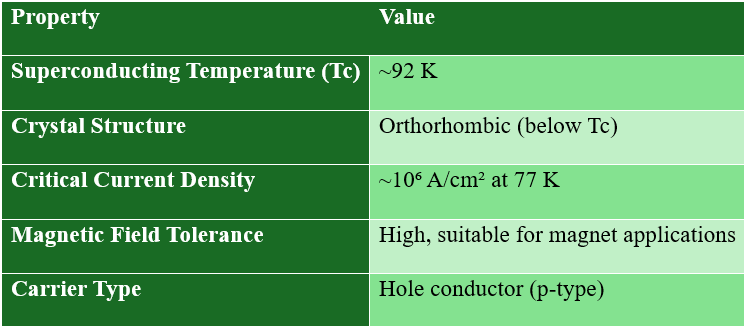YBCO-
A High-Temperature superconductor (HTS)
Superconductors have long been the field of research for physicists and engineers due to their unique ability to conduct electricity with zero resistance. Among the most celebrated breakthroughs in this field is Yttrium Barium Copper Oxide (YBCO) — a high-temperature superconductor (HTS) discovered in 1987. It marked the first material to exhibit superconductivity above the boiling point of liquid nitrogen (77 K), revolutionizing the feasibility of practical superconducting technologies.
What is YBCO?
YBCO stands for Yttrium Barium Copper Oxide, with the general formula:
YBa₂Cu₃O₇₋ₓ, where x ranges between 0 and 1. This compound belongs to the family of cuprate superconductors and is characterized by layered perovskite structures
Key Properties of YBCO:

Structure and Superconductivity Mechanism
YBCO consists of CuO₂ planes, which are primarily responsible for superconductivity. These planes are separated by layers containing yttrium and barium atoms. The superconducting behaviour arises due to Cooper pairing of electrons (or holes), facilitated by lattice vibrations (phonons) and magnetic interactions — although the exact mechanism in cuprates is still debated.
Oxygen Content and Superconductivity
The value of x in YBa₂Cu₃O7-x determines the oxygen stoichiometry, directly affecting the superconducting transition temperature (Tc). Full oxygenation (x ≈ 0) gives optimal Tc (~92 K), while oxygen deficiency can destroy superconductivity.
Synthesis and Fabrication Techniques
- Solid-State Reaction: Mixing Y₂O₃, BaCO₃, and CuO, followed by calcination and sintering.
- Pulsed Laser Deposition (PLD): Used to fabricate YBCO thin films with precise crystalline orientation, especially for electronics.
- Metal Organic Chemical Vapor Deposition (MOCVD): Preferred for large-scale coated conductors.
Challenges in Fabrication:
- Maintaining oxygen stoichiometry
- Achieving epitaxial growth
- Avoiding secondary phase formation (e.g., BaCuO₂)
YBCO stands as a cornerstone in the field of high-temperature superconductivity. With its critical transition temperature above 77 K and wide-ranging applications from quantum devices to power grids, it remains a focus of both fundamental research and industrial innovation. Despite its challenges, continuous advancements in synthesis and nanostructuring are paving the way for scalable and sustainable superconducting technologies.
